The Hens and Chicks Plant (Sempervivum tectorum) has MANY other names. This adorable evergreen flowering succulent has a long and rich history with humans.
Humans have loved and grown various kinds of hens and chicks plants for thousands of years. Historically, it’s known as the common houseleek.
Other colorful terms for it are St. George’s Beard, St. Patrick’s Cabbage and healing blade.
Over the millennia, folks have planted this edible succulent on rooftops to ward off storms and provide food in emergencies.
This succulent plant’s medical uses are mentioned in ancient herbal medical treatises. It is noted as a treatment for certain eye diseases and other things way back to Pliny.
It even has a history of mystical uses.
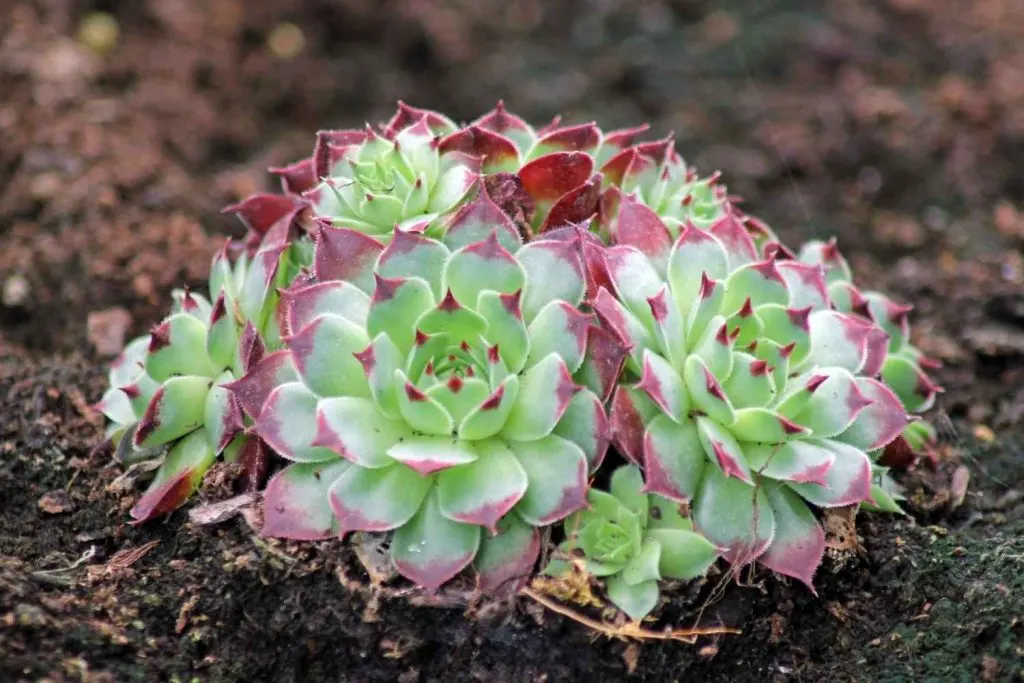
How Hens and Chicks Grow Outdoors:
As an outdoor ornamental plant, Hens and chicks succulents make wonderful rock garden additions. They do well in dry outdoor gardens with full sun for 6 to 8 hours a day.
Hens and chick will survive in very dry high heat locations. But they are native to the mountains of Southern Europe. Not a dessert.
Since these plants can survive cold, even somewhat wet weather, they also do well in temperate climate zones outdoors.
Hens and chicks grows into interesting rosettes of many colors. This plant has a low profile from just a few inches high, up to 12 inches.
There are HUNDREDS of cultivars of hens and chicks. Find your favorites and share them with us. We love to share pics of your plants on our instagram stories. Just tag us!
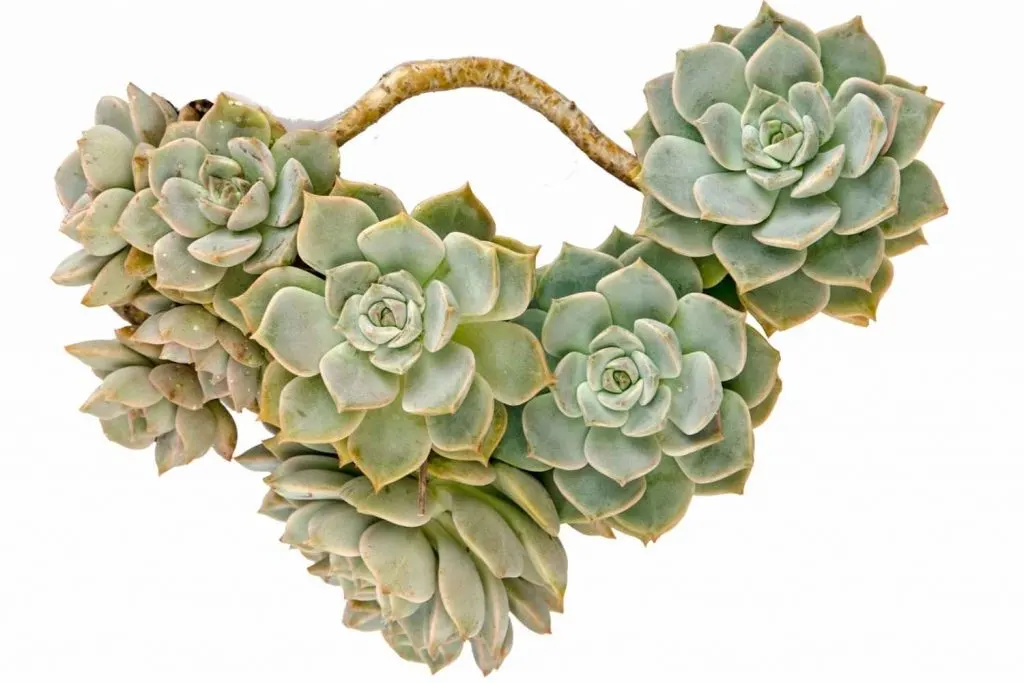
For growing Outdoors, Place your hens and chicks plant where it can spread into a ground cover for best effect.
It loves dry sandy soil with LOTS of sun. Contrarily, this plant will also grow in a moderate temperature zone.But the soil must drain well.
A constantly high(over 85 degrees F) intensely dry heat that continues for several weeks will cause it shrink and go dormant.
When the temperatures moderate the plant should revive with a good watering. The stems and rosettes crawl around and make mounds and ground coverings and drape down wall edges.
Hens and Chicks Flowers:
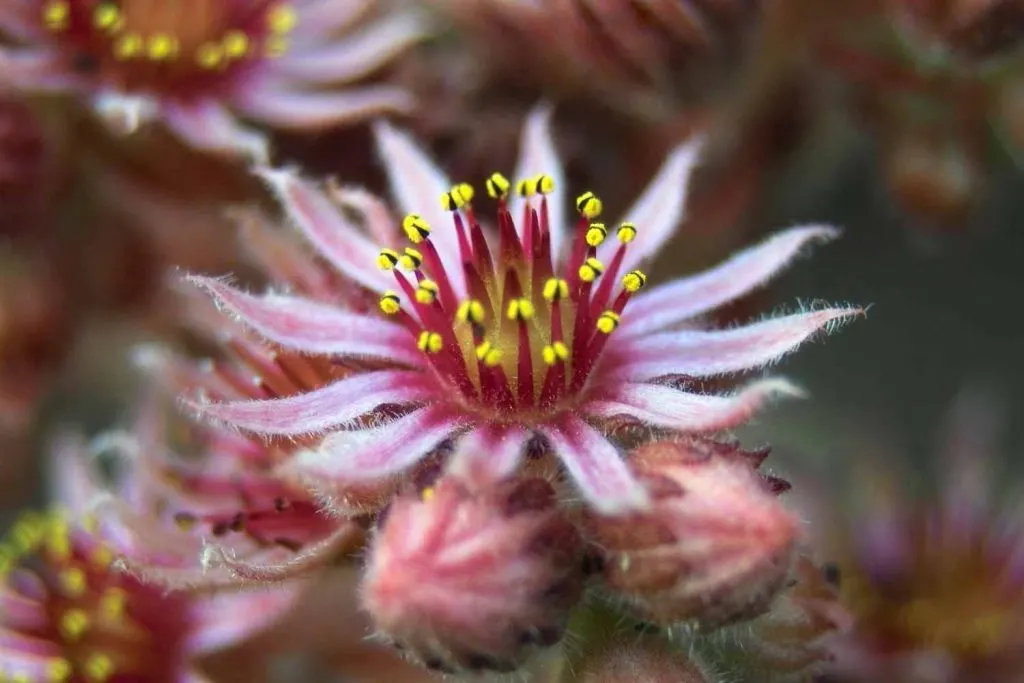
Sempervivum tectorum grows its flowers on long stems. The flowers provide an interesting counterpoint to the round rosette globular leaves.
The stems are long, flat and jagged with dry daisy shaped flowers growing off the ends.
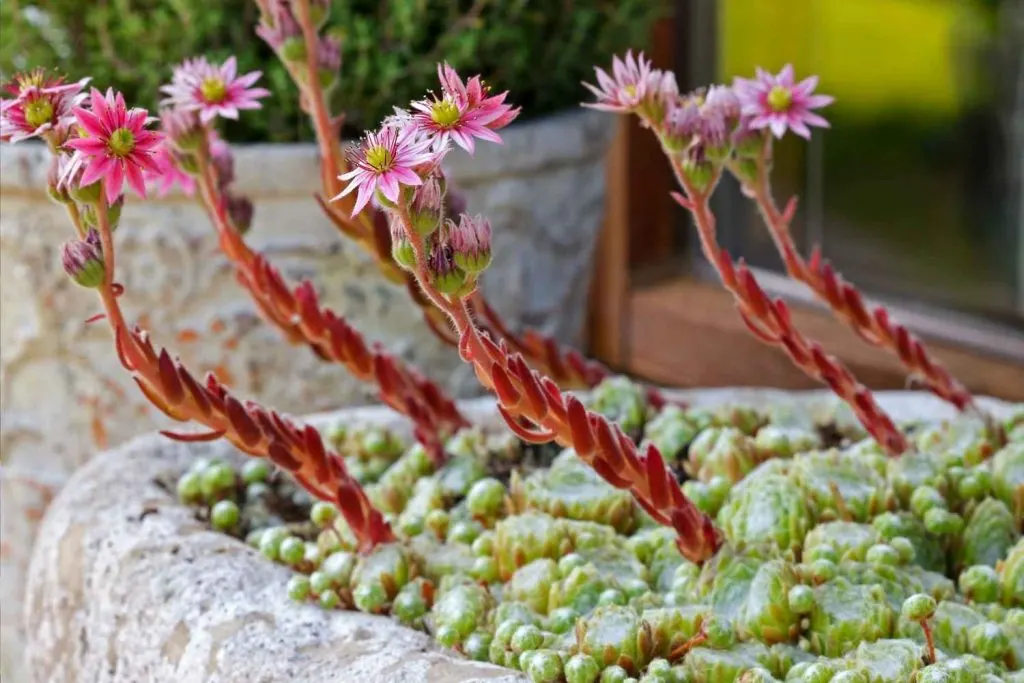
Propagation:
This plant propagates naturally by offsets. This means the plant grows identical baby plants. Eventually the offsets grow shallow roots and create a network of rosettes. Some cultivars grow offsets that fall off the mother plant and self seed into the soil below the mom plant.
In this way, hens and chicks grow in clusters or groupings. They grow as ground covers. They self propagate and continue to increase their cluster size over the years.
If the baby plants find no way to feed themselves they shrink up, dry, and eventually blow away. Occasionally you will see these tiny plants self sow into other areas of your garden beds. At least I do in my (temperate)yard. 🙂
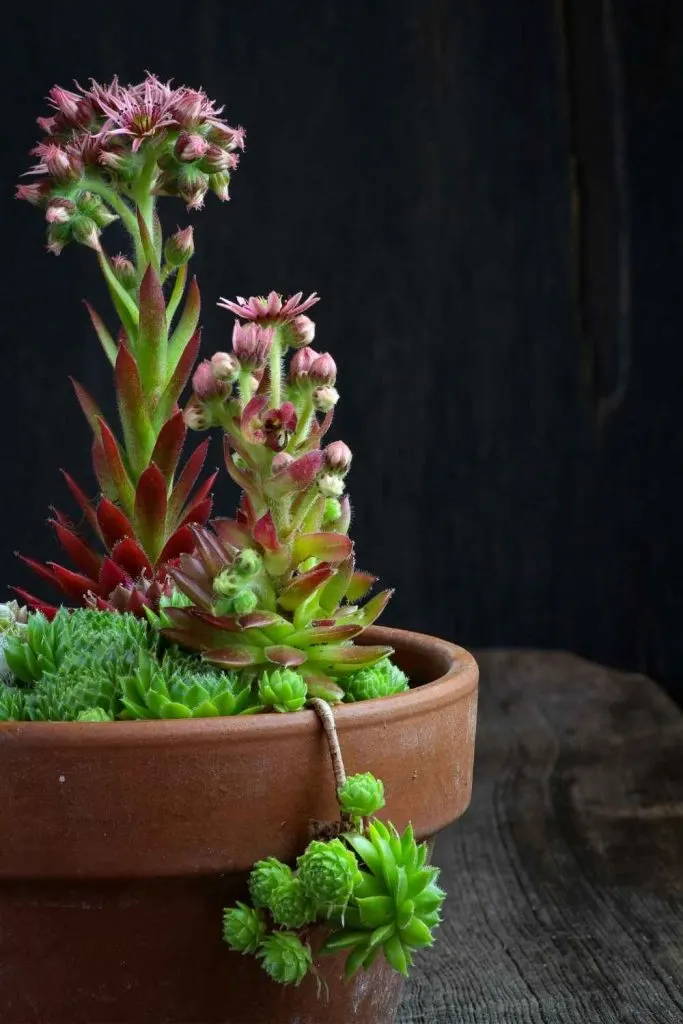
Hens and Chicks Planter Ideas:
Hens and Chick pots can be in literally any pot that drains well. Terra cotta pots are excellent for this succulent since it wicks water away from the plant roots.
Outdoors, Shallow, wide or long rectangular planters suit the hens and chicks very well. Clusters of rosettes form as they mature and propogate.
Window boxes, brick planter boxes by an outdoor porch or any low patio pot are great choices. Hens and chicks grow fine in planters on patios.
They group well with other heat loving plants.
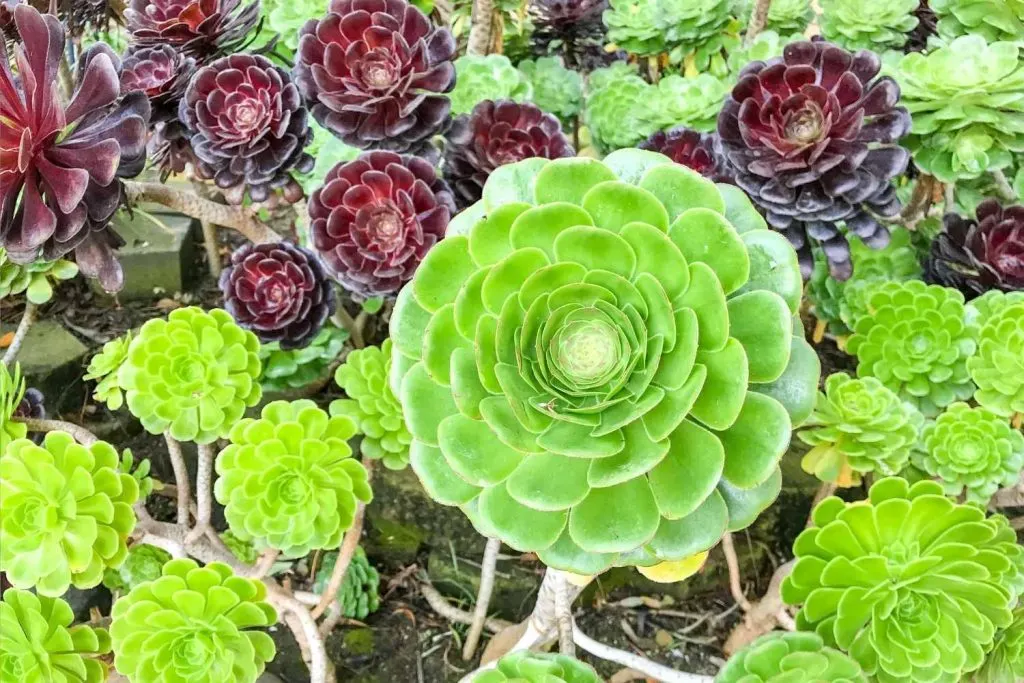
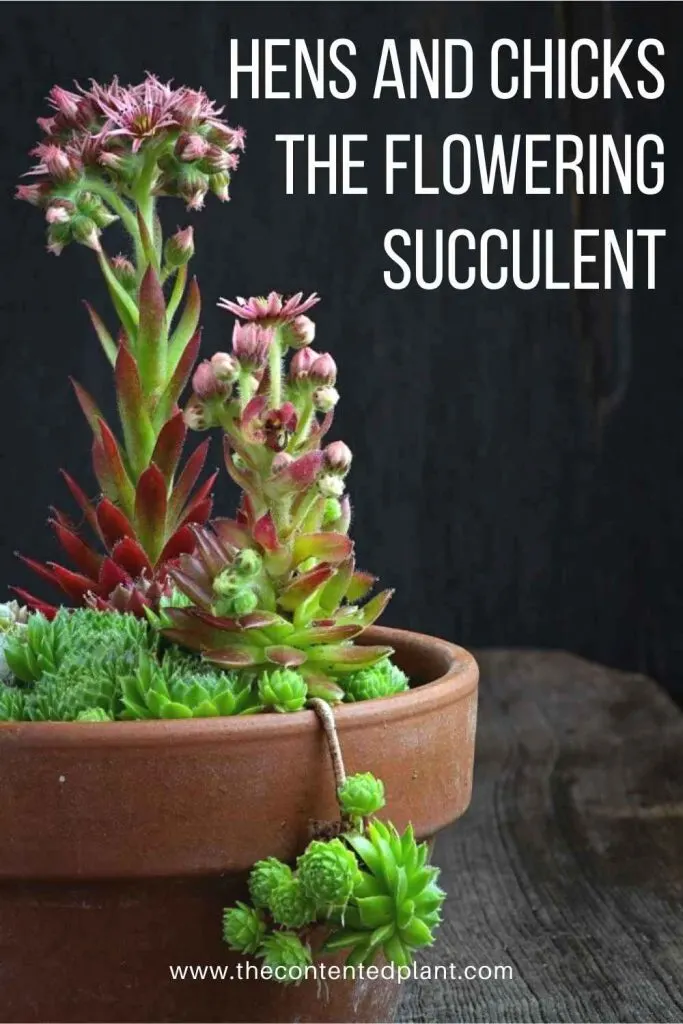
Hens and Chick Care Indoors:
Hens and chicks plants also makes a great houseplants. It has a few requirements and limitations you must respect. Read our care guide below for more indoor growing tips.
This succulent LOVES light and requires it. This is one of the few houseplants you might grow that does best in your strong direct light from a south or west facing window.
This is a non toxic plant you can feel good about. Your kids and pets are safe with the hens and chicks plant.
Hens and Chicks Plant Care Indoors
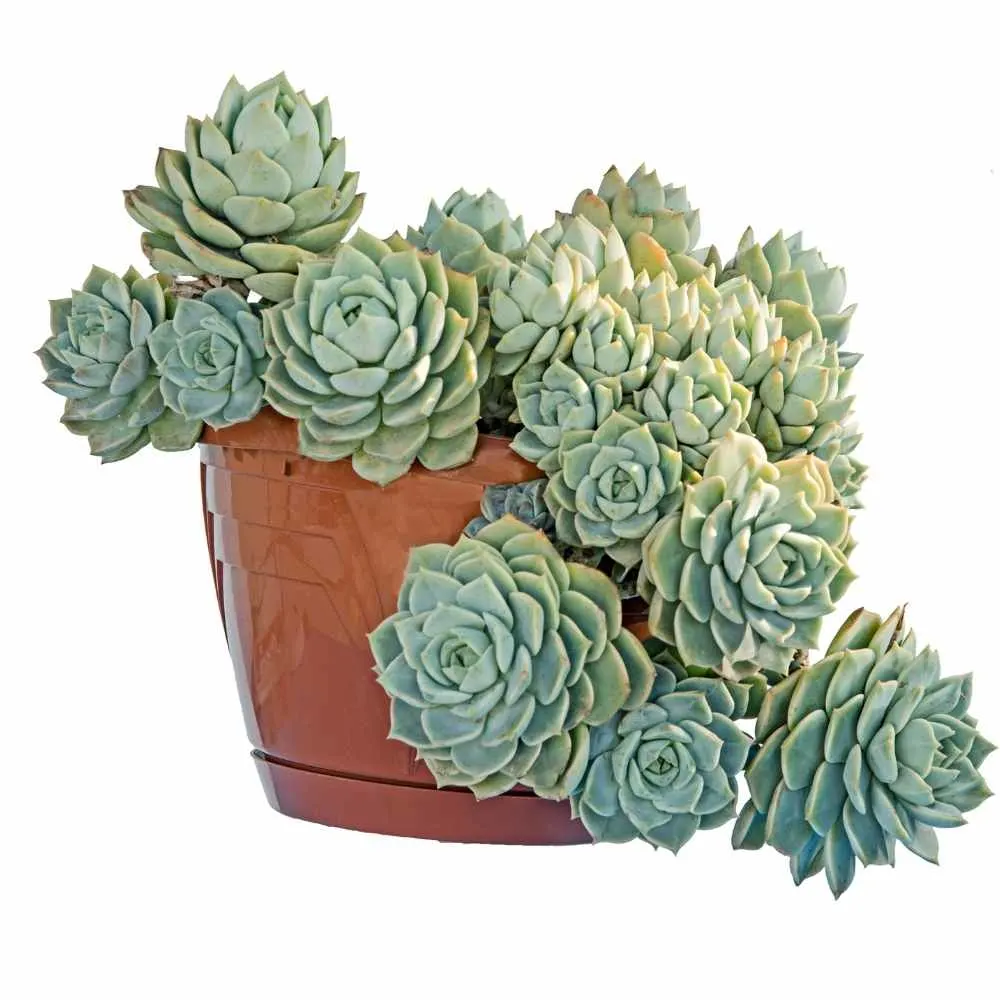
Hens and Chicks have many cultivars of different colors and styles.
This plant has fleshy globular leaves the grow in a rosette pattern on long thick stems. This plant flowers in good conditions..
This Care Guide will teach you how to keep this houseplant happy all through the year.
Materials
Instructions
Soil Preference:
- Hens and Chicks plants prefer a well draining cactus soil mix. The roots will rot quickly if they sit in moist soil.
- A mix of cactus potting mix, sand and perlite will keep the roots happiest.
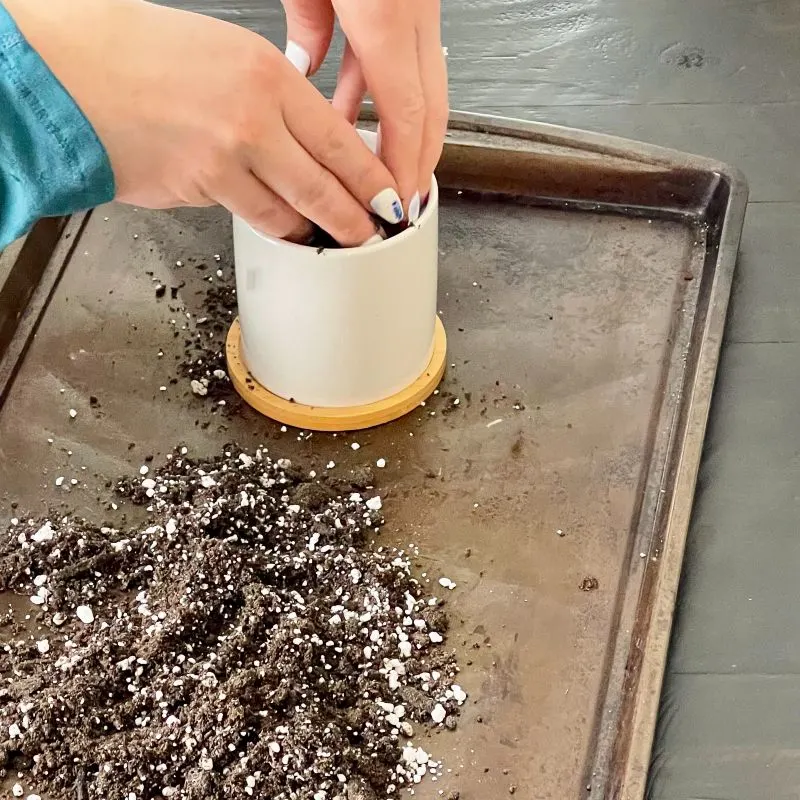
- Make sure your pot has drainage at the bottom. Do not use a pot with no drainage hole for this plant.
- A heavy soil potting mix is not recommended for succulent plants.
Pot Size and Type:
- Hens and chicks can grow in many different kinds of pots, I like to plant mine in ceramic pots with a drainage hole. I linked an Amazon page of adorable cactus pots above for you.
- Repot every second year or when roots come out the drainage holes on the pot bottom To the next pot size up. Don't jump to a huge pot from a small one. Just go to the next size up pot.
- Shallow rectangular or round pots are perfect for hens and chicks since this plant crawls and drapes orver planter edges.
- Large shallow posts allow this ground cover to form masses, which it naturally wants to do.
Lighting:
- Hens and chick plants will grow best in bright light for 6 to 8 hours a day.
- Set this succulent in a south or west window where it can recieve direct light. If the plant shows signs of burning set it back further.
Watering:
- Water these succulent plants when the soil is dry. They are drough resistant and can withstand long periods of dryness.
- Watering is best done by drenching the plant thoroughly. Allow the water to run through the pot and then let it drain so no water sits in the bottom drain plate.
- Do not allow water to sit in the center of the leaves and accumulate.This can cause crown rot at the leaf intersections.
- The recommendation watering cycle is every 2-3 weeks.
- Never let this plant get wet feet. Overwatering encourages root rot and fungus gnats.
How to Fertilize:
- Apply a fertilizer (linked in materials) diluted by 50% once in the summer months. Hen and chick plants do not need much fertilizer.
- Allow the plant to rest through the winter months with no fertilizer.
Temperature:
- These plants will do best in temperatures between 30-85 degrees F. For this reason they can grow outdoors in climate zones 10a to 11b.
Pests:
- Hens and chicks plants are hardy resilient plants. However all plants can get attacked by pests.
- Stress by longterm overwatering, poor light, extreme temperatures and soil conditions are contributors to plant stress..
- Spider mites, mealy bugs, scale, thrips and whitefly are the most common houseplant pests you will see.
- Read our post on How to get rid of aphids and other pests with our homemade pesticide soap recipe or neems oil.
- To minimize the possibility of pests be sure to check all nursery plants before bringing them home.
- Quarantine all new plants until you are sure no pests live in them.
How to Propagate by stem cutting:
- Cut a stem off the plant with a rosette.
- Plant it in a small pot in wet cactus soil.
- After several weeks roots will grow and settle the new plant.
How to Propagate by Offsets:
- Hens and chicks plants naturally grow new plants around their outer perimeter. These are called offsets.
- You can easily unpot your plant and pull the offsets off the mother plant.
- Repot the rooted offsets in separate pots in cactus soil.
- Water thoroughly. They should settle in fine.
Notes
The hens and chicks Plant is a rewarding and perfect plant for a beginner succulent parent. This plant will grow beautifully with just a little bit of care.
TIP: This plant loves air flow. Don't group it with a lot of other humid loving plants. An open window nearby with warm dry air will keep it happy through the warm months.
The video below is for the Zebra plant. However, the care needs of the hens and chick plant are very similar.
Follow Us:
Find us on YouTube, Instagram , Pinterest and TikTok! We love to Plant chat. We also comment, like and occasionally share your content to our daily stories. We’d love to see your plants. Share your joy in your houseplants. Happy Planting!


Echeveria Plants: Why We Love them - The Contented Plant
Friday 28th of July 2023
[…] Hen and chicks plants (Echeveria Secunda)are one of the most popular members of the Echeveria genus.They are great for rock gardens, ground covers and border plants. […]
Sansevieria Cylindrica Plant Care Guide and Profile - The Contented Plant
Saturday 5th of February 2022
[…] Hens and Chicks Plant […]
Watering Succulents-Tips for Success - The Contented Plant
Friday 14th of January 2022
[…] rhizomes, roots and leaves. Some examples of this are the ZZ plant, Ponytail Palm, snake plants, hens and chicks and […]